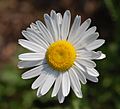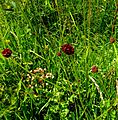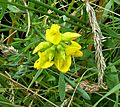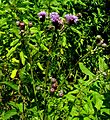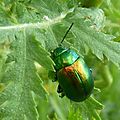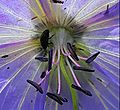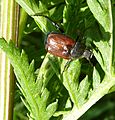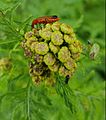Acaster South Ings facts for kids
| Site of Special Scientific Interest | |
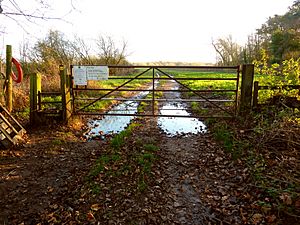
Acaster South Ings, north gateway
|
|
| Area of Search | North Yorkshire |
|---|---|
| Grid reference | SE594437 |
| Interest | Biological |
| Area | 38.3 ha (95 acres) |
| Notification | 1988 |
| Location map | Magic Map (Defra) |
Acaster South Ings is a special place near York, England. It's called a Site of Special Scientific Interest (SSSI). This means it's protected because of its important plants and animals. It has two big flood-meadows, which are fields that sometimes get covered by river water.
This area became an SSSI in 1988. It's home to many different kinds of plants and animals. Some of these are quite rare in the Vale of York region. For example, you can find the special tansy beetle here. This beetle loves to eat the leaves of the tansy plant.
Contents
What is Acaster South Ings?
Acaster South Ings is a protected area that covers about 38.3 hectares. That's about the size of 70 football fields! It has two large meadows that often flood. These meadows are right next to the River Ouse. They are about 4 miles south of York.
Wet grasslands like these are rare in the United Kingdom. This is because many have been drained or changed for farming. Acaster South Ings is special because it keeps its natural wet grassland habitat.
You can visit the site by walking along a public path. This path runs along the River Ouse from Acaster Malbis through Acaster Marine.
Why is this site protected?
The site was first made an SSSI in 1988. It's protected because it has rare plants and insects. It's one of nine wildlife SSSIs in the wider York area. Other protected sites nearby include Strensall Common and Askham Bog.
Acaster South Ings is also one of four special riverside hay meadow SSSIs. These are listed by the Yorkshire Dales Rivers Trust. The others are Clifton Ings and Rawlcliffe Meadows, Fulford Ings, and Naburn Marsh.
Plants at Acaster South Ings
This special meadow is home to many different plants.
Grasses and Meadow Flowers
You can find many types of grasses here. These include great burnet, red fescue, creeping bent, meadow foxtail, Yorkshire fog, and crested dog's tail.
Many beautiful flowering plants grow in the flood meadows. Look for bird's foot trefoil and ox eye daisy. You might also see common sorrel and red clover. Other flowers include common knapweed, meadowsweet, ribwort plantain, and meadow buttercup.
Some parts of the grassland have lots of common bistort. Other areas have common meadow rue and pepper saxifrage.
Plants on the Dykes and Riverside
The site is protected from floods by earth dykes. These dykes are drier than the meadows. Different plants grow here that like drier soil. These include meadow cranesbill, field mouse ear, and clustered bellflower.
Along the river, you'll find trees and shrubs. These include osier (a type of willow) and hawthorn. Taller plants like tansy, butterbur, common mugwort, reed canary grass, and great willowherb also grow by the river.
Animals at Acaster South Ings
This site is important for protecting special animals too.
Special Beetles
Two types of beetles are protected here. The rare tansy beetle is one of them. It gets its name because it eats the leaves of the tansy plant. Another protected beetle is Aphthona nigriceps, a type of flea beetle. This beetle lives on the meadow cranesbill plant.
Wading Birds
The curlew is a wading bird that breeds here. This is one of the few good places for wading birds to have their babies in the Vale of York. If you visit in spring, please keep dogs on leads. This helps protect the young birds during their breeding season.
How the site is cared for
People work hard to take care of Acaster South Ings. This is called "active management." It helps to protect all the plants and animals that live there.
Farmers use traditional methods to manage the land. They cut the hay (grass) in early July. This happens after the curlews have had their young. It also happens after the special plants have dropped their seeds. This cutting stops tall plants from growing too much. It also prevents old plants from building up.
After the hay is cut, animals like cows might graze in the fields. This happens in late summer to early autumn. The grazing animals are then moved out in autumn.
Workers also regularly clean the ditches and drains. This helps to control the water levels in the meadows.
Currently, experts say the site's condition is "unfavourable - recovering." This means it was not in the best shape before, but it is now getting better.
Images for kids









